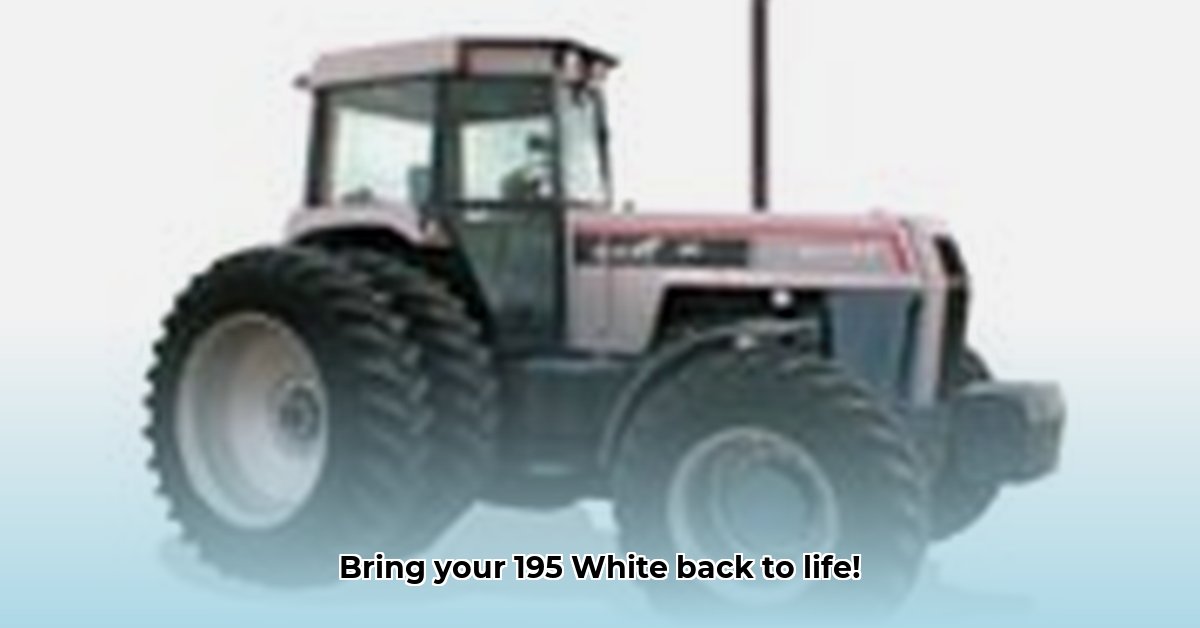
195 White Tractor: A Historical Overview and Specifications
The White 195 tractor, a powerful machine produced sometime between 1990 and 1992, represents a fascinating chapter in agricultural history. Commanding a hefty price of $66,000 at its launch, this workhorse was equipped with a robust CDC-Cummins 8.3L 6-cylinder diesel engine, an 18-speed partial power shift transmission, and 4-wheel drive. This combination yielded impressive power outputs: approximately 163.56 drawbar horsepower and 187.55 PTO horsepower. Its robust build made it exceptionally well-suited for demanding agricultural tasks. However, a challenge in researching this tractor is the inconsistency of information across various sources. Specifications such as wheelbase length vary, highlighting a need for further dedicated research and documentation to fully understand this model's specifications. This lack of readily available data makes restoring a White 195 a unique, albeit challenging, undertaking. Despite the information gaps, its historical significance as a durable and powerful farming implement remains clear. For more on classic tractors, check out this resource.
Restoration and Maintenance Guide: Bringing Your 195 White Back to Life
Restoring a White 195 is a rewarding yet demanding project. It requires methodical planning, patience, and a commitment to detail. The following steps will guide you through the process:
Information Gathering: Begin by compiling as much information as possible. Explore online forums dedicated to classic tractors, connect with experienced restorers and owners, and actively search for original manuals and service records.
Parts Sourcing: This is often the most challenging aspect. Explore salvage yards, online auction sites, and specialized parts suppliers. Networking with other White 195 owners is invaluable for accessing hard-to-find components. Consider creative approaches and part fabrication as needed.
Engine Maintenance (CDC-Cummins 8.3L): Regular maintenance is vital. Schedule routine fluid changes (oil, coolant, transmission fluid, hydraulic fluid), filter replacements (air, fuel, oil), and inspections for potential leaks or damage. Employ a diesel mechanic experienced with older engines for any complex repairs.
Hydraulic System Inspection: Carefully examine the hydraulic system, looking for leaks or damage. Proper fluid levels are paramount for operational efficiency. Neglecting this system can lead to significant and costly repairs.
Transmission Service (18-Speed): The 18-speed transmission requires meticulous care. Gentle operation and proactive servicing help prevent problems. Consult an expert if any significant repairs are needed.
Bodywork Restoration: If aiming for a complete restoration, addressing bodywork is a substantial aspect. This involves thorough cleaning, rust repair, and repainting. This stage is particularly time-consuming and requires skillful application.
Sustainable Agriculture Considerations: Assessing the Environmental Impact of the White 195
Using a vintage tractor like the White 195 in contemporary agriculture raises significant questions related to sustainability. While restoring and using an existing machine avoids the environmental impact of manufacturing a new one, several factors require careful consideration:
Fuel Efficiency: While precise fuel efficiency data for the White 195 is currently unavailable, we can compare it to modern tractors with equivalent power outputs to estimate its relative fuel consumption. Further research into fuel consumption and engine efficiency for this specific model would provide much needed additional information.
Emissions: Older diesel engines generally produce higher emissions than modern ones. However, the overall environmental impact depends on the tractor's usage frequency compared to modern equivalents. Proper maintenance minimizes emissions.
Soil Compaction: The weight of the White 195, like any tractor, can lead to soil compaction. Proper tire pressure management can mitigate this to some degree, but it remains a crucial factor in sustainable farming practices.
Economic Sustainability: Restoration and maintenance costs of a vintage tractor should be carefully weighed against the acquisition and operating expenses of modern machines. The long-term cost may be very different from initially anticipated costs.
Legal and Regulatory Compliance: Understanding Local Laws
Before operating your restored White 195, thoroughly familiarize yourself with all relevant local, regional, and national regulations. Noise ordinances, emission standards, and safety requirements vary significantly. Non-compliance can result in penalties. Consult the appropriate authorities beforehand to ensure legal operation.
Conclusion: The White 195 – A Sustainable Choice?
The White 195 tractor presents a compelling case study in sustainable agriculture. While restoring and maintaining it requires significant investment, it offers a potential alternative for niche applications such as heritage farming or smaller-scale operations. Its robust construction favors longevity, reducing overall manufacturing impact compared to frequent new tractor purchases. However, careful consideration of fuel efficiency, emissions, and soil compaction, along with full compliance with local regulations, is crucial for responsible and sustainable agricultural practices. Further research into this model is essential to fully understand its environmental effects and improve sustainability practices.